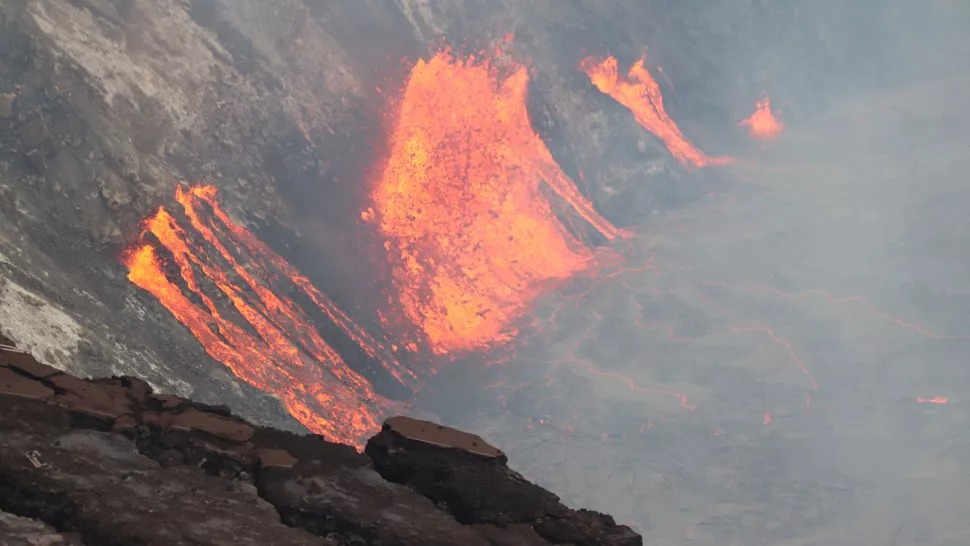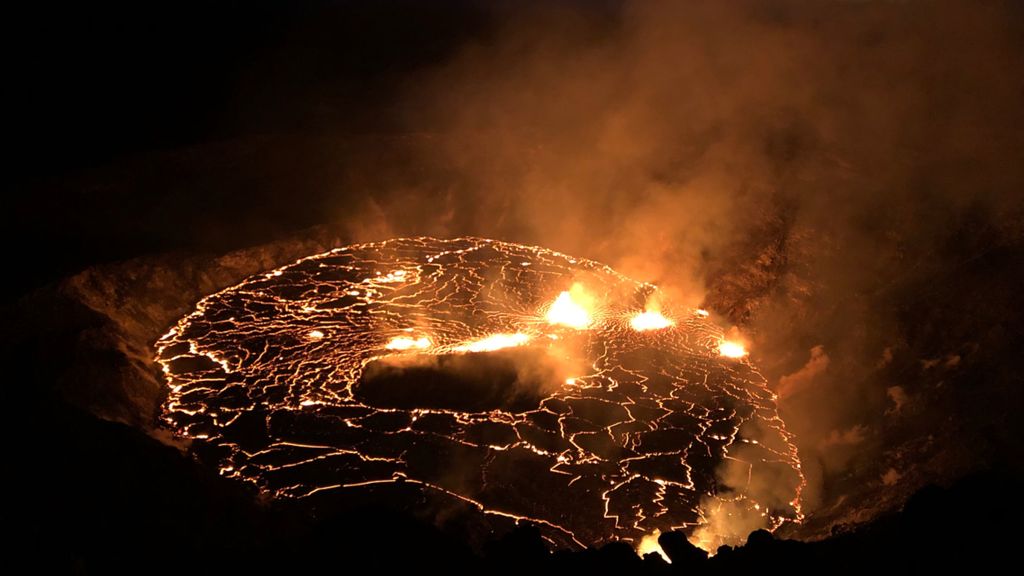Kilauea volcano is erupting, sending lava and thread-like pieces of volcanic glass, known as Pele's hair, into Hawaii's skies, according to the US Geological Survey (USGS) and the National Weather Service.
The eruption began at about 3:20 pm local Hawaii time Wednesday (Sept. 29), when the USGS Hawaiian Volcano Observatory detected a glow from its webcam at Kilauea summit. That glow indicated a lava eruption happening at Halema'uma'u crater – a pit crater nestled in the much larger Kilauea caldera, or crater.
The webcam footage also revealed fissures at the base of Halema'uma'u crater that were releasing lava flows onto the surface of the lava lake that had been active until May 2021, the USGS said in a statement.
 Telephoto image of fissures that opened at Halema'uma'u crater. (M. Patrick/USGS)
Telephoto image of fissures that opened at Halema'uma'u crater. (M. Patrick/USGS)
However, the eruption at Kilauea – located within Hawaii Volcanoes National Park, on Hawaii's Big Island – is confined to Halema'uma'u crater, meaning it's not currently a threat to the public.
Related: Photos: Fiery lava from Kilauea volcano erupts on Hawaii's Big Island
"At this time, we don't believe anybody or any residents are in danger, but we do want to remind folks the park remains open," Cyrus Johnasen, a Hawaii County spokesperson, told Hawaii news station KHON2 on Sept. 29.
"It will remain open until the evening. Please proceed with caution," especially for those with respiratory conditions, he added.
However, the part of the park where the eruption is happening is currently closed to the public, according to the USGS.
Due to the eruption, the Hawaiian Volcano Observatory has elevated Kilauea's volcano alert level from "watch" to "warning" and its aviation color code from orange to red, which warns pilots about possible ash emissions.
Those are the highest warning levels, meaning a "major volcanic eruption is imminent, underway or suspected, with hazardous activity both on the ground and in the air," according to the USGS.
 Lava fountains are spurting out at multiple fissure, September 30, Halema'uma'u. (B Carr/USGS)
Lava fountains are spurting out at multiple fissure, September 30, Halema'uma'u. (B Carr/USGS)
Meanwhile, several pilots flying aircraft near Kilauea Wednesday evening reported seeing volcanic glass known as Pele's hair, according to the National Weather Service.
The golden, sharp strands of glass – named for Pele, the Hawaiian goddess of fire and volcanoes – form when gas bubbles within lava burst at the surface.
"The skin of the bursting bubbles flies out, and some of the skin becomes stretched into these very long threads, sometime[s] as long as a couple of feet [more than half a meter] or so," Don Swanson, a research geologist at the Hawaiian Volcano Observatory, previously told Live Science.
Pele's hair can be beautiful, but it poses a danger if it's ingested through drinking water, Swanson cautioned.
The current eruption is the latest of a long string of volcanic activity at Kilauea. At an elevation of 4,009 feet (1,222 m) aboveground, the shield-shaped volcano has a magma-pumping system that extends more than 37 miles (60 kilometers) below Earth, according to the USGS. Kilauea has erupted 34 times since 1952, and it erupted almost continuously from 1983 to 2018 along its East Rift Zone.
A vent at Halema'uma'u crater was home to an active lava pond and a vigorous gas plume from 2008 to 2018.
Kilauea's volcanic activity also made headlines in May 2018, when the lava lake at the summit caldera drained just as the Eastern Rift Zone revved to life with lava fountains and new fissures, whose lava created a red-hot river that destroyed hundreds of houses before draining into the ocean.
From December 2020 to May 2021, a summit eruption made a lava lake within Halema'uma'u crater, and in August 2021, a series of small earthquakes rattled the summit.
Related Content:
Big blasts: History's 10 most destructive volcanoes
5 colossal cones: Biggest volcanoes on Earth
This article was originally published by Live Science. Read the original article here.
#Nature | https://sciencespies.com/nature/massive-eruption-at-kilauea-is-sending-glass-hair-into-the-sky-pilots-report/
No comments:
Post a Comment